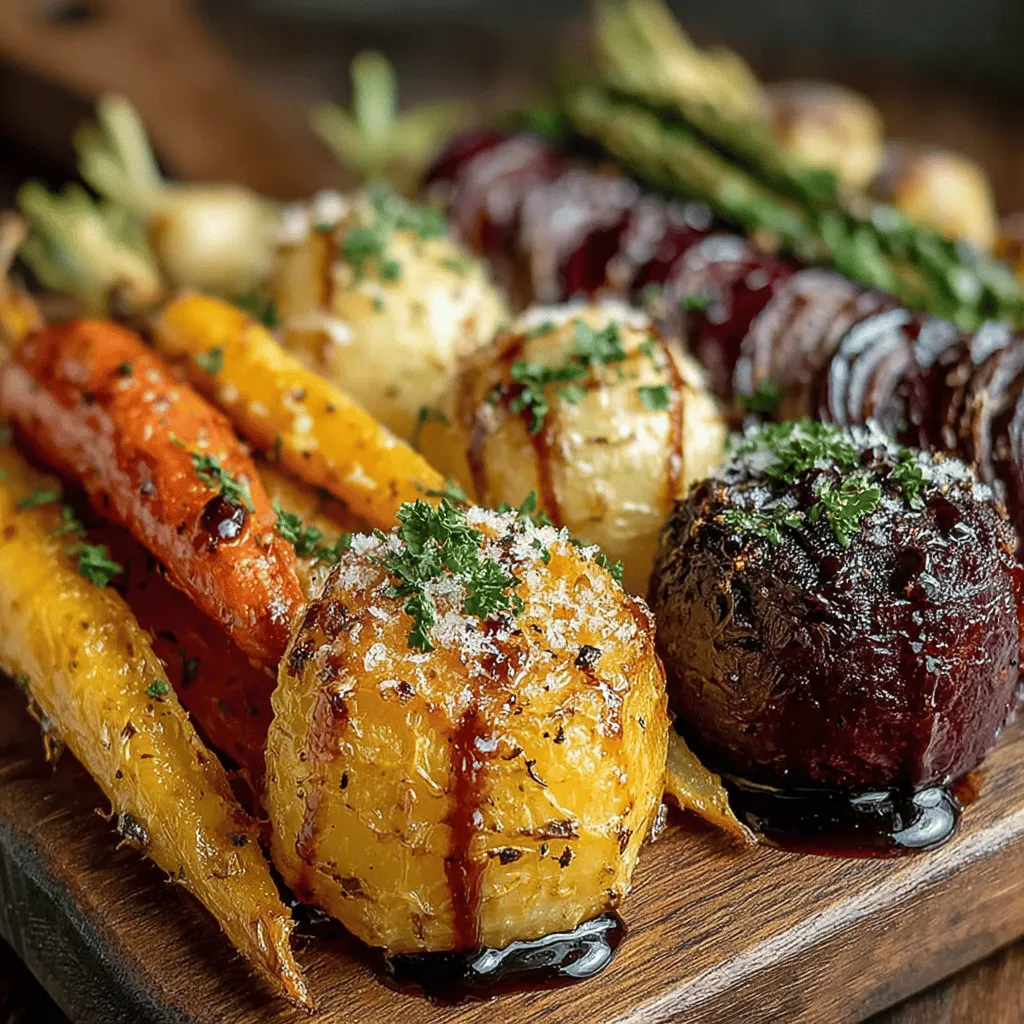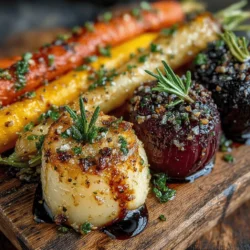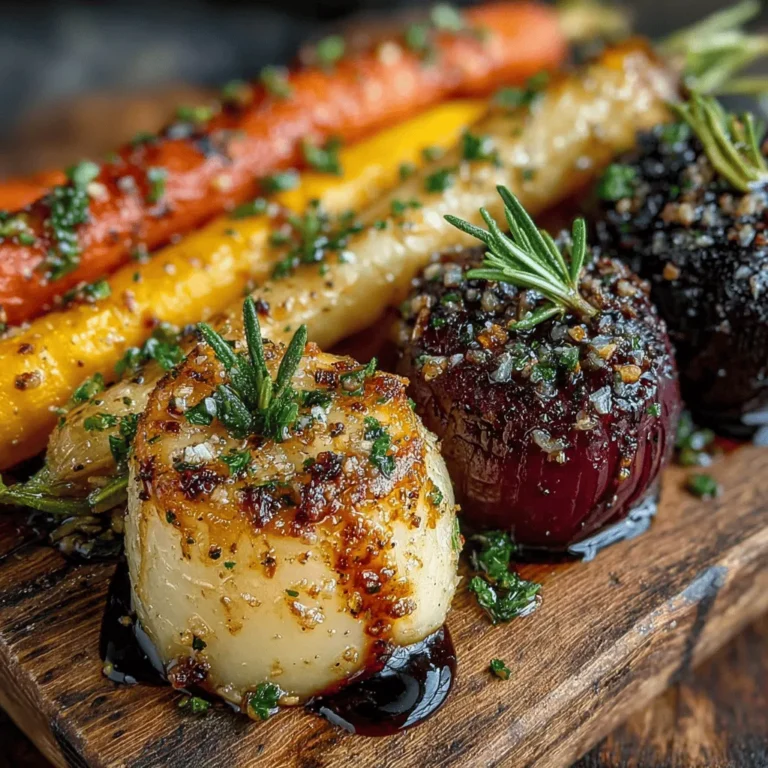Earthy Harmony: The Ultimate Guide to Roasted Root Vegetables
Roasted root vegetables are a timeless culinary classic that brings warmth and comfort to any dining table. Their earthy flavors and vibrant colors not only create a visually appealing dish but also deliver a wealth of nutritional benefits. The recipe “Earthy Harmony: Roasted Root Vegetables” celebrates the unique characteristics of root vegetables while demonstrating the art of roasting in a way that enhances their natural sweetness and texture. In this guide, we will explore the background of root vegetables, the essential techniques for roasting, and a detailed breakdown of the ingredients that make this dish a true harmony of flavors.
Understanding Root Vegetables
Defining Root Vegetables
Root vegetables are edible plants that grow underground, forming the base of the plant’s structure. These vegetables are typically harvested for their nutrient-rich roots, which serve various culinary purposes. They are categorized as tubers, bulbs, or taproots and are known for their ability to thrive in diverse climates. Common examples include carrots, parsnips, sweet potatoes, and beets.
Nutritionally, root vegetables are powerhouses packed with vitamins, minerals, and dietary fiber. They are excellent sources of antioxidants, which help combat oxidative stress and inflammation in the body. Additionally, their high fiber content promotes digestive health, making them a valuable addition to any diet.
Popular Types of Root Vegetables
– Carrots: Carrots are perhaps the most recognized root vegetable, available in various colors, including orange, purple, and yellow. They are rich in beta-carotene, which the body converts into vitamin A, promoting eye health and boosting the immune system. Carrots also have a natural sweetness that enhances their flavor when roasted.
– Parsnips: Often overshadowed by their orange counterparts, parsnips are a unique root vegetable with a sweet, nutty flavor. They contain high levels of vitamins C and K, as well as folate and fiber. When roasted, parsnips develop a caramelized exterior that complements their creamy interior.
– Sweet Potatoes: A nutritional powerhouse, sweet potatoes are high in vitamins A and C, potassium, and fiber. Their natural sweetness makes them a favorite in both savory and sweet dishes. Roasting sweet potatoes brings out their rich flavors and creates a delightful contrast in texture.
– Beets: Beets are renowned for their vibrant color and earthy flavor. They are an excellent source of antioxidants, particularly betalains, which have anti-inflammatory properties. Roasting beets enhances their sweetness and brings out a depth of flavor that can elevate any dish.
The Art of Roasting
Why Roast Root Vegetables?
Roasting is a cooking technique that transforms root vegetables into a delightful dish by enhancing their natural sweetness through caramelization. When exposed to high heat, the sugars in the vegetables caramelize, resulting in a rich, golden-brown exterior that contrasts beautifully with the tender, soft interior. This method of cooking not only amplifies the flavors of the vegetables but also adds appealing textures—creating a crispy outside while keeping the inside melt-in-your-mouth tender.
Essential Techniques for Perfect Roasting
To achieve the best results when roasting root vegetables, there are several essential techniques to keep in mind:
– Preheating the Oven: Preheating the oven to the optimal temperature—typically between 400°F to 425°F (200°C to 220°C)—is crucial for achieving that perfect roast. The high heat is necessary to promote caramelization, resulting in beautifully browned vegetables.
– The Importance of Spacing: When placing the vegetables on the baking sheet, it is essential to leave enough space between each piece. Overcrowding can lead to steaming rather than roasting, preventing the vegetables from achieving that desired crispy texture. Aim for a single layer to allow even heat distribution.
– Stirring Midway: To ensure uniform cooking and browning, stir the vegetables midway through the roasting process. This simple technique helps to promote even exposure to the heat, ensuring that every piece reaches its full potential in terms of flavor and texture.
Ingredients Breakdown
Essential Ingredients for Earthy Harmony
Creating the “Earthy Harmony: Roasted Root Vegetables” dish involves selecting fresh, high-quality ingredients that complement one another. Here’s a closer look at each component:
– Carrots: These vibrant and sweet vegetables serve as the backbone of the dish. Their natural sugars caramelize beautifully during roasting, contributing to the overall sweetness and color of the dish.
– Parsnips: Adding parsnips introduces a unique flavor profile that balances sweetness with earthy notes. They enhance the complexity of the dish, making it more interesting and satisfying.
– Sweet Potatoes: Incorporating sweet potatoes provides a creamy texture and additional sweetness. Their bright color also adds visual appeal, making the dish more inviting.
– Beets: The earthy flavor of beets adds depth to the dish, while their deep color creates a stunning visual contrast. They also contribute a wealth of nutrients, making the dish not only delicious but also healthful.
– Fresh Herbs: Fresh herbs like rosemary and thyme are essential for elevating the flavors of the roasted vegetables. Their aromatic qualities infuse the dish with a fresh, herbal essence that perfectly complements the earthy tones of the root vegetables.
– Olive Oil: Choosing the right kind of olive oil is crucial for roasting. Opt for a high-quality extra virgin olive oil that adds richness and helps in achieving that crispy texture while enhancing the flavors of the vegetables.
– Balsamic Vinegar (Optional): Adding a drizzle of balsamic vinegar before serving can elevate the dish further. The tangy sweetness of balsamic vinegar enhances the caramelized flavors of the vegetables, making them even more delectable.
Step-by-Step Instructions
As we dive into the step-by-step instructions for preparing “Earthy Harmony: Roasted Root Vegetables,” you will discover how straightforward and rewarding this process can be. Each step is designed to highlight the natural beauty and flavors of the vegetables, ensuring that you create a stunning dish that is both comforting and nutritious.
Stay tuned for the detailed instructions that will guide you through the preparation and roasting of these delightful root vegetables, leading you to a satisfying culinary experience that embodies the essence of earthy harmony.

Preheat the Oven
To begin your journey toward perfectly roasted root vegetables, preheating your oven is essential. A hot oven creates the ideal environment for roasting, ensuring that the vegetables develop a beautifully caramelized exterior while becoming tender and flavorful on the inside. Set your oven to 425°F (220°C) and give it ample time to reach this temperature. A well-preheated oven helps to lock in moisture and enhances the natural sweetness of the vegetables, resulting in a dish that is both comforting and delectable.
Prep the Vegetables
The next step involves preparing your root vegetables for roasting. Select a variety of root vegetables, such as carrots, potatoes, parsnips, beets, and sweet potatoes, to create a colorful and nutritious medley.
Techniques for Cutting and Preparing Vegetables for Roasting
1. Washing: Thoroughly wash your vegetables under running water to remove any dirt or debris. For those with thicker skins, consider scrubbing them with a vegetable brush.
2. Peeling: Depending on the type of root vegetable, peeling may be necessary. For example, beets and carrots benefit from peeling, while many potatoes can be roasted with the skin on for added texture and nutrients.
3. Cutting: Aim for uniform sizes to ensure even cooking. Cut your vegetables into bite-sized pieces—about 1 to 2 inches—so they roast evenly and are easy to eat. For larger vegetables like sweet potatoes and beets, cut them into smaller cubes, while carrots can be sliced into rounds or sticks.
Seasoning for Success
Now that your vegetables are prepped, it’s time to season them to elevate their flavors.
How to Properly Coat Vegetables with Oil and Seasoning
1. Choosing the Right Oil: Use an oil with a high smoke point, such as olive oil, avocado oil, or vegetable oil. This allows for a crispy finish without burning.
2. Coating: Place your prepared vegetables in a large mixing bowl. Drizzle with oil—about 2-3 tablespoons for a large batch—ensuring even coverage. Toss the vegetables thoroughly to coat them evenly.
3. Seasoning: Sprinkle with salt, pepper, and any additional herbs or spices you desire, such as rosemary, thyme, garlic powder, or paprika. Toss again to distribute the seasoning evenly. Remember, the key to flavorful roasted vegetables lies in the seasoning, so don’t be shy—experiment with different combinations to find your favorite.
Arranging on the Baking Sheet
Proper arrangement on the baking sheet is critical for achieving optimal roasting.
Tips for Achieving Optimal Roasting Through Proper Arrangement
1. Single Layer: Spread the seasoned vegetables in a single layer on a large baking sheet. Overcrowding can cause them to steam rather than roast, leading to a less desirable texture.
2. Space Them Out: Leave space between the pieces to allow hot air to circulate. This encourages even cooking and enhances browning.
3. Use Parchment Paper: Lining your baking sheet with parchment paper can help prevent sticking and make for easier cleanup.
Roasting to Perfection
With your oven preheated and vegetables arranged, it’s time to roast them to perfection.
Timing Considerations: Knowing When Vegetables Are Done
Place the baking sheet in the oven and set a timer for 25-30 minutes. The exact roasting time will depend on the size and type of vegetables used.
Signs of Perfect Roasting: Fork-tender and Caramelized
Check for doneness by piercing the vegetables with a fork. They should be fork-tender but not mushy. Additionally, look for a golden-brown caramelization on the edges—this indicates delicious roasting. If they aren’t quite there after 30 minutes, continue roasting, checking every five minutes until the desired texture is achieved.
Finishing Touches
Once your vegetables are roasted to perfection, it’s time to add finishing touches that will take the dish to the next level.
Adding Balsamic Vinegar: When and How to Incorporate It
For a delightful tang, drizzle a tablespoon or two of balsamic vinegar over the roasted vegetables just before serving. This step adds a layer of acidity that balances the sweetness of the root vegetables and enhances their flavor profile. Toss gently to combine, ensuring the vinegar evenly coats the vegetables.
Garnishing with Parsley: Elevating Presentation and Flavor
Finally, sprinkle freshly chopped parsley over the roasted vegetables. This not only adds a pop of color, enhancing visual appeal, but also contributes a fresh, herbal note that complements the earthiness of the dish.
Serving Suggestions
Roasted root vegetables can stand alone as a hearty side dish or serve as a complementary component to various main dishes.
Complementary Main Dishes: Proteins That Go Well with the Dish
Consider pairing your roasted root vegetables with proteins such as:
– Roasted Chicken: The savory flavors of roasted chicken harmonize beautifully with the sweetness of the vegetables.
– Grilled Salmon: The rich, buttery flavor of salmon provides a lovely contrast to the earthiness of the roots.
– Vegetarian/Vegan Options: For a meatless meal, serve with quinoa or lentils, which provide protein and balance the dish.
Suggestions for Sides and Salads to Balance the Meal
To complete your meal, consider adding a light side salad. A simple arugula salad with a lemon vinaigrette can provide a refreshing contrast. Alternatively, a grain-based salad, such as farro or quinoa tossed with nuts and dried fruits, complements the roasted vegetables nicely.
Health Benefits of Roasted Root Vegetables
Root vegetables are not only delicious but also offer numerous health benefits.
Nutritional Insights
Root vegetables are rich in essential vitamins and minerals, including:
– Beta-Carotene: Found in carrots and sweet potatoes, it supports eye health and boosts the immune system.
– Fiber: Many root vegetables are high in dietary fiber, promoting digestive health and aiding in weight management.
– Antioxidants: Vegetables like beets contain antioxidants that help combat oxidative stress in the body.
How Roasting Preserves Nutrients
Roasting is a cooking method that helps to retain many nutrients compared to boiling, which can cause nutrient loss in water. The roasting process can also enhance the flavors, making it more enjoyable to consume these nutrient-rich foods.
Seasonal Eating: Why Choosing Seasonal Root Vegetables is Beneficial
Opting for seasonal root vegetables not only enhances flavor but also supports local farmers and reduces environmental impact. Seasonal vegetables are often fresher, more nutritious, and more affordable. Additionally, choosing locally sourced produce reduces the carbon footprint associated with transportation.
Conclusion
In conclusion, “Earthy Harmony: Roasted Root Vegetables” not only offers a delicious way to enjoy the natural flavors of seasonal produce but also provides an array of health benefits. This versatile dish can be a centerpiece or side, appealing to various palates and dietary preferences. By understanding the ingredients, mastering the roasting technique, and appreciating the nutrition behind root vegetables, you can create a dish that warms the heart and nourishes the body. Enjoy the earthy harmony it brings to your dining experience.


